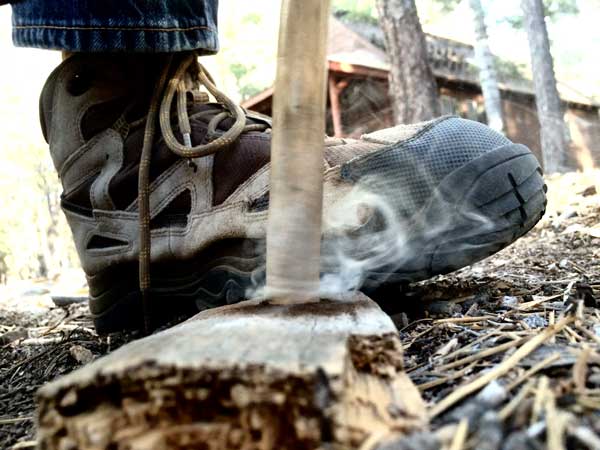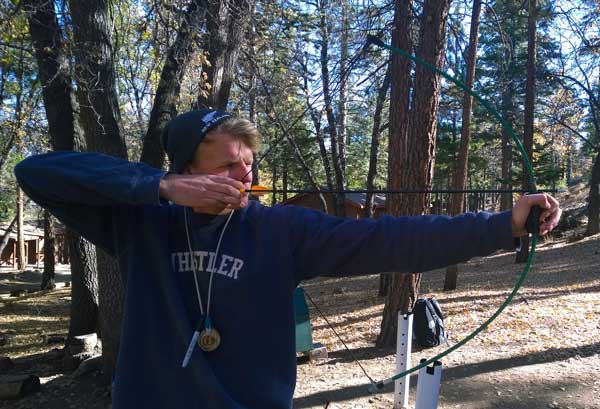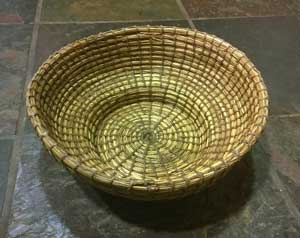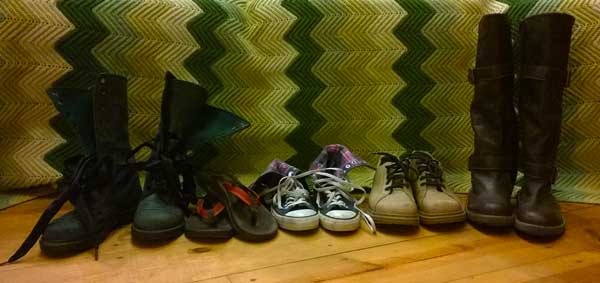Ahhh… there’s nothing like a new pair of shoes. The smell, the fresh laces, the feeling like you could conquer the world. Right now I’m asking you to imagine yourself in a new pair of shoes, but not the kind that is fresh out of the box. I’m asking you to join me for Native Culture class and to, figuratively, put on someone else’s shoes.
Native Culture class? At outdoor science school?
Some students see no correlation, but that is what makes this class all the more fun. Culture is an important topic to study “solely” for the purpose of gaining a new perspective; so that’s exactly what we do!

Listen For A Moment
“Close your eyes and imagine yourself sitting underneath the huge Coulter, Sugar, Jeffery, and Ponderosa pines of this very forest. You hear the wind blow through the needles above, and you can’t help but think about your ancestors from generations past watching over you and protecting you as the strong pines loom above. Right now you are on a hunt, searching for a deer to bring back to your tribe. You have a bow in hand and a quiver of arrows on your back”.
“Surveying the land for any signs of movement, you notice giant claw marks across the surface of a granite boulder. You can’t help but feel like you are being watched by the creature, yet the feelings quickly pass as you ponder, in awe, the sheer size and strength of the bear”.
“As you walk, your thoughts wander back to life at home. Right now, family members and friends are starting fires and finishing up the daily duties of foraging for food, basket weaving, collecting wood and repairing tools such as arrows and bow drills. You can already imagine the smell of the food over the fire and hear the voices and instruments played in unison as you celebrate another productive day – as is tradition from the ancestors and elders of the Yuhaviatam”.
“The sight of a deer one hundred yards upwind jolts you back to your senses. You nock your arrow and slowly feel the tension in the bow’s arms increase as you draw back the string to your right cheek. Everything is silent and perfect. Just then, the deer turns its gaze to you. You make eye contact for a full ten seconds before you slowly lower your bow and allow the deer to pass by. There’s always tomorrow, for a moment as sacred as that should never be interrupted.”

For a moment, did you imagine yourself as a member of the Yuhaviatam? Could you picture the forest and relate to the thought of family, work, and celebration?
When we take the time to learn about new cultures and “put on a new pair of shoes,” we gain a bit of perspective into our world that we’ve never experienced before. In this class, we learn that the Yuhaviatum were social people who were both skillful and self expressive. They also fostered a deep respect for their ancestors and for the nature that surrounded them. The question is not “who are the Yuhaviatam?” but “why are they the Yuhaviatam?”
Why were they a social group? Why were they skillful? Why do they share a deep respect for nature and elders?
 In order to answer these questions, let’s think back to our little story. Maybe they cherished socialization and celebration because they were intentional about fostering a community. They lived together, worked together, and needed to learn how to respect and get along with each other.
In order to answer these questions, let’s think back to our little story. Maybe they cherished socialization and celebration because they were intentional about fostering a community. They lived together, worked together, and needed to learn how to respect and get along with each other.
Maybe they were skillful because they had to be. If you were not a skillful archer, then you could not eat meat. If you could not weave a tight basket, then you could not store those scarce and precious amounts of water.
 Perhaps they exercised respect for their elders because they believed as an individual experiences life, they also gain wisdom that can be passed down from generation to generation.
Perhaps they exercised respect for their elders because they believed as an individual experiences life, they also gain wisdom that can be passed down from generation to generation.
Maybe they had a respect for nature because they lived so closely to it. There was no disconnect between the water they drank, the food they ate, the wood and stones that built their homes, and the fire that cooked their meals, boiled their water, and kept them warm. It was common sense to keep their water clean, to not waste an ounce of food, and to respect their community and environment.
Similarities and Differences
One thing I can’t help but ponder is realizing how many similarities there are between the Yuhaviatam and cultures across the world today. There is humanness about culture that transcends both time and all cultural barriers. In the end, we are all humans who seek to express ourselves through various values, traditions, activities, languages, etc.
Even so, there are many differences between cultures. Since this is an outdoor science school, one comparison I like to discuss with my students is the Yuhaviatam’s relationship with nature versus our current relationship with nature.
The Yuhaviatam developed a respect for nature because they understood their lives or quality of life depended on it. Every time you turn on the water, do you think about the river or groundwater in which the water came from? Every time you eat, do you think about the entire process it took for every ingredient to get on your plate? Every time you throw something in the trash, do you know where it is going?
Pondering over these questions with my students helps me to become more and more aware of the disconnect between humans and the natural world that is widening in our society.
How can we learn from the Yuhaviatam to improve our own culture?
The point of this question is not to get children thinking about how certain cultures may seem more superior or that their culture needs improving. The point of this question is to help my students understand that bridging the relational gap between cultures can help us to bridge the gap in our own cultural shortfalls. In other words, we can learn a thing or two from one another! I believe this idea is extremely important to keep in mind and teach to our students, considering we live in a very diverse community.
Even though High Trails is an outdoor science school, this is not just a place to pass on scientific facts and other nuggets of information. This is a place that provides experiential learning in order to help our students gain a new perspective and worldview; in more ways than one. So with that said, go out and lace up a new pair of shoes! I think you’ll be glad you did.

At High Trails Outdoor Science School, we literally force our instructors to write about elementary outdoor education, teaching outside, learning outside, our dirty classroom (the forest…gosh), environmental science, outdoor science, and all other tree hugging student and kid loving things that keep us engaged, passionate, driven, loving our job, digging our life, and spreading the word to anyone whose attention we can hold for long enough to actually make it through reading this entire sentence. Whew…. www.dirtyclassroom.com

Comments are closed.